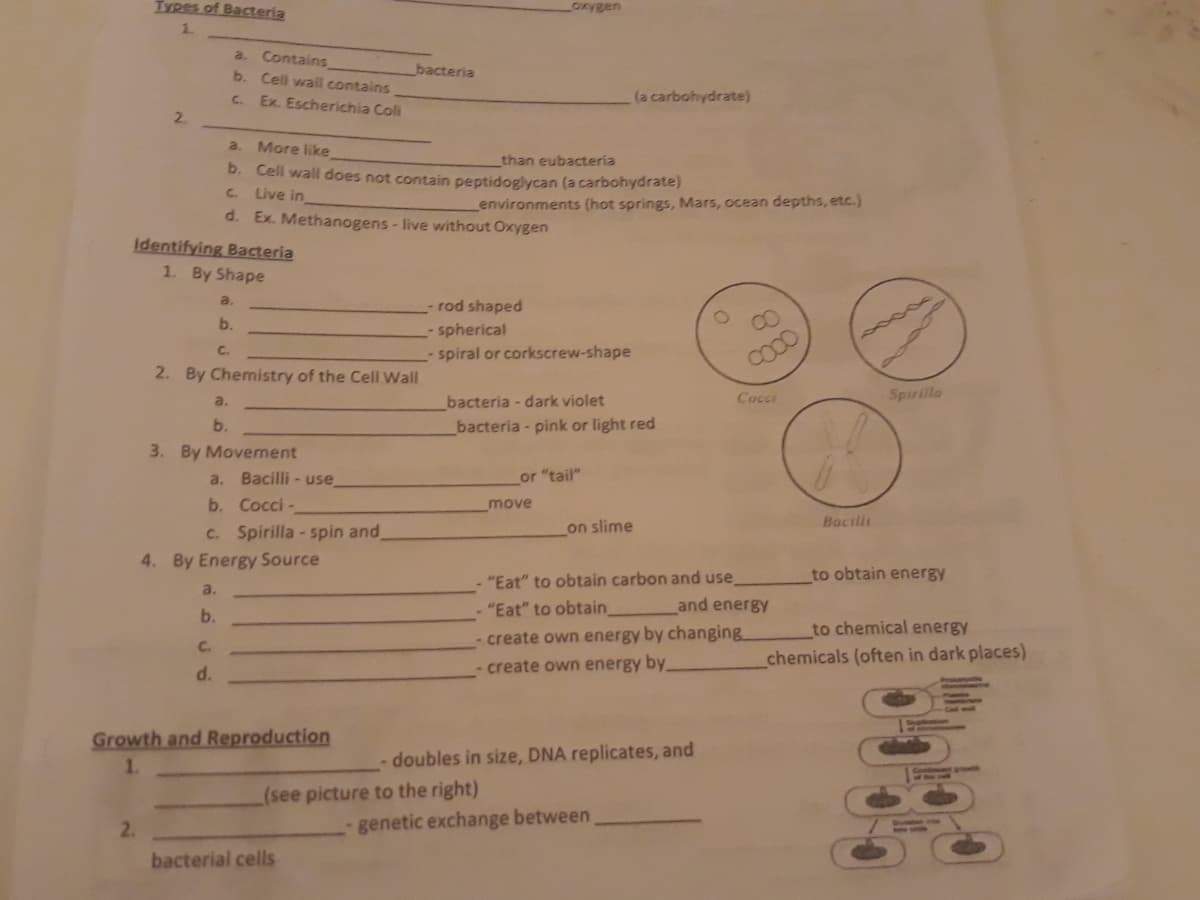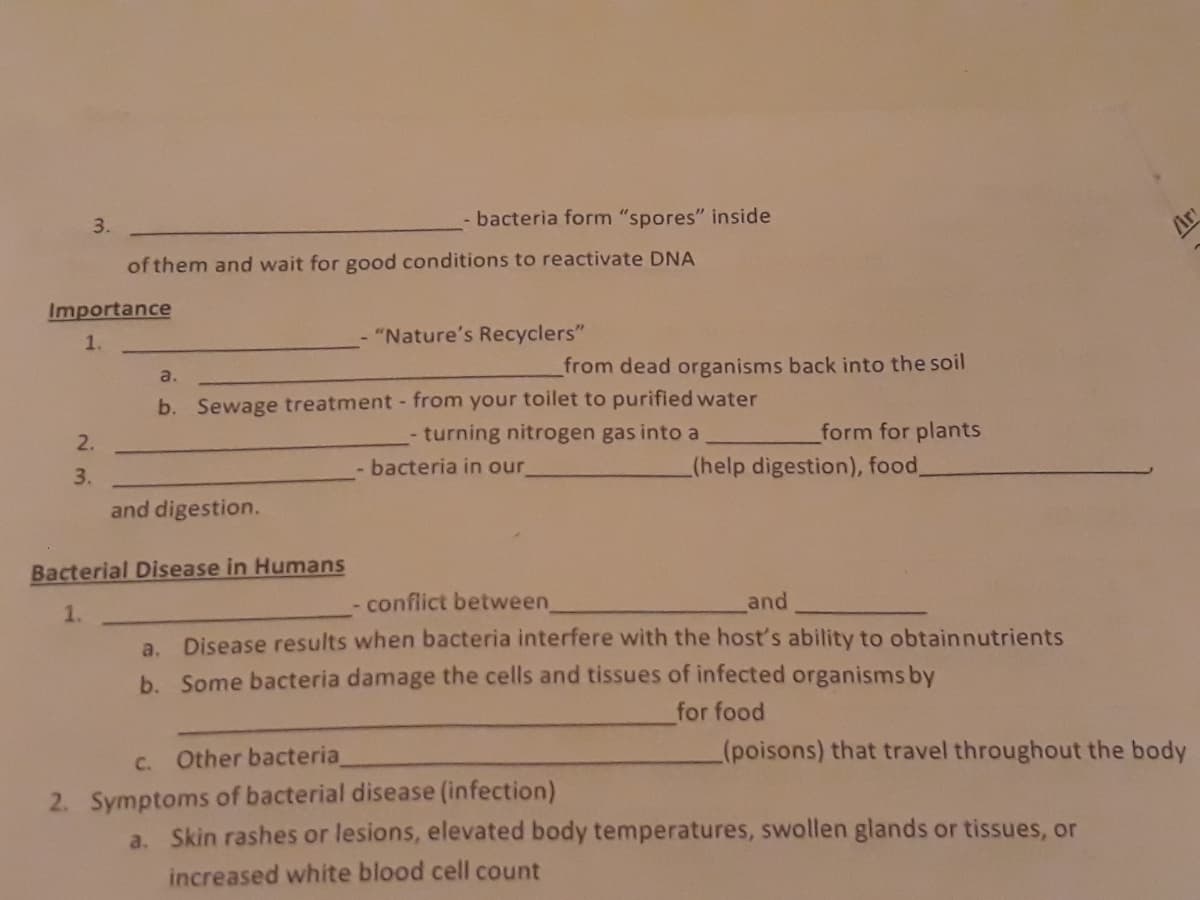like than eubacteria D. Cell wall does not contain peptidoglycan (a carbohydrate) Live in d. Ex. Methanogens-live without Oxygen C. environments (hot springs, Mars, ocean depths, etc.) Ing Bacteria By Shape a. rod shaped - spherical - spiral or corkscrew-shape b. 8. C. Chemistry of the Cell Wall bacteria - dark violet Cocci Spirilla a. b. bacteria - pink or light red Movement a. Bacilli - use or "tail" b. Cocci - C. Spirilla - spin and Energy Source move Bacilit on slime to obtain energy "Eat" to obtain carbon and use "Eat" to obtain create own energy by changing - create own energy by. a. and energy b. to chemical energy c. chemicals (often in dark places) Reproduction doubles in size, DNA replicates, and (see picture to the right) genetic exchange between
like than eubacteria D. Cell wall does not contain peptidoglycan (a carbohydrate) Live in d. Ex. Methanogens-live without Oxygen C. environments (hot springs, Mars, ocean depths, etc.) Ing Bacteria By Shape a. rod shaped - spherical - spiral or corkscrew-shape b. 8. C. Chemistry of the Cell Wall bacteria - dark violet Cocci Spirilla a. b. bacteria - pink or light red Movement a. Bacilli - use or "tail" b. Cocci - C. Spirilla - spin and Energy Source move Bacilit on slime to obtain energy "Eat" to obtain carbon and use "Eat" to obtain create own energy by changing - create own energy by. a. and energy b. to chemical energy c. chemicals (often in dark places) Reproduction doubles in size, DNA replicates, and (see picture to the right) genetic exchange between
Biology: The Dynamic Science (MindTap Course List)
4th Edition
ISBN:9781305389892
Author:Peter J. Russell, Paul E. Hertz, Beverly McMillan
Publisher:Peter J. Russell, Paul E. Hertz, Beverly McMillan
Chapter26: Prokaryotes: Bacteria And Archaea
Section: Chapter Questions
Problem 9TYK
Related questions
Question
100%

Transcribed Image Text:IYpes of Bacteria
oxygen
1.
a. Contains
b. Cell wall contains
bacteria
Ex. Escherichia Coli
(a carbohydrate)
C.
2.
a. More like
than eubacteria
b. Cell wall does not contain peptidoglycan (a carbohydrate)
C. Live in
environments (hot springs, Mars, ocean depths, etc.)
d. Ex. Methanogens- live without Oxygen
Identifying Bacteria
1. By Shape
a.
rod shaped
spherical
spiral or corkscrew-shape
b.
Cc.
2. By Chemistry of the Cell Wall
Cocci
Spirilla
a.
bacteria - dark violet
b.
bacteria - pink or light red
3. By Movement
a. Bacilli - use
or "tail"
b. Cocci -
move
Bactlii
C. Spirilla - spin and
on slime
4. By Energy Source
to obtain energy
- "Eat" to obtain carbon and use
and energy
a.
b.
"Eat" to obtain
to chemical energy
- create own energy by changing
C.
- create own energy by
chemicals (often in dark places)
d.
Growth and Reproduction
1.
doubles in size, DNA replicates, and
(see picture to the right)
2.
genetic exchange between
bacterial cells

Transcribed Image Text:3.
- bacteria form "spores" inside
of them and wait for good conditions to reactivate DNA
ir
Importance
1.
"Nature's Recyclers"
a.
from dead organisms back into the soil
b. Sewage treatment - from your toilet to purified water
2.
turning nitrogen gas into a
form for plants
(help digestion), food,
3.
- bacteria in our
and digestion.
Bacterial Disease in Humans
1.
conflict between
and
a. Disease results when bacteria interfere with the host's ability to obtainnutrients
b. Some bacteria damage the cells and tissues of infected organisms by
for food
c. Other bacteria
(poisons) that travel throughout the body
2. Symptoms of bacterial disease (infection)
a. Skin rashes or lesions, elevated body temperatures, swollen glands or tissues, or
increased white blood cell count
Expert Solution
This question has been solved!
Explore an expertly crafted, step-by-step solution for a thorough understanding of key concepts.
This is a popular solution!
Trending now
This is a popular solution!
Step by step
Solved in 2 steps

Knowledge Booster
Learn more about
Need a deep-dive on the concept behind this application? Look no further. Learn more about this topic, biology and related others by exploring similar questions and additional content below.Recommended textbooks for you

Biology: The Dynamic Science (MindTap Course List)
Biology
ISBN:
9781305389892
Author:
Peter J. Russell, Paul E. Hertz, Beverly McMillan
Publisher:
Cengage Learning

Human Heredity: Principles and Issues (MindTap Co…
Biology
ISBN:
9781305251052
Author:
Michael Cummings
Publisher:
Cengage Learning

Biology (MindTap Course List)
Biology
ISBN:
9781337392938
Author:
Eldra Solomon, Charles Martin, Diana W. Martin, Linda R. Berg
Publisher:
Cengage Learning

Biology: The Dynamic Science (MindTap Course List)
Biology
ISBN:
9781305389892
Author:
Peter J. Russell, Paul E. Hertz, Beverly McMillan
Publisher:
Cengage Learning

Human Heredity: Principles and Issues (MindTap Co…
Biology
ISBN:
9781305251052
Author:
Michael Cummings
Publisher:
Cengage Learning

Biology (MindTap Course List)
Biology
ISBN:
9781337392938
Author:
Eldra Solomon, Charles Martin, Diana W. Martin, Linda R. Berg
Publisher:
Cengage Learning


Comprehensive Medical Assisting: Administrative a…
Nursing
ISBN:
9781305964792
Author:
Wilburta Q. Lindh, Carol D. Tamparo, Barbara M. Dahl, Julie Morris, Cindy Correa
Publisher:
Cengage Learning